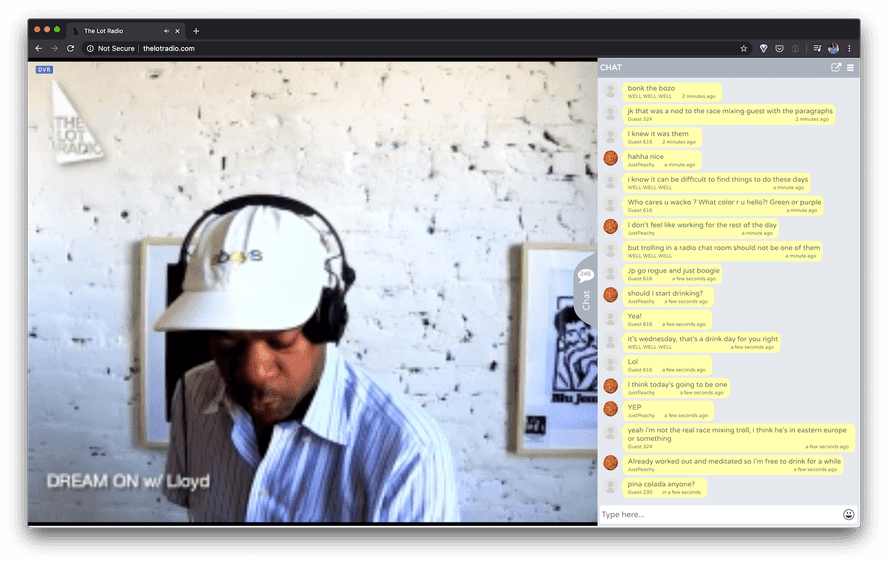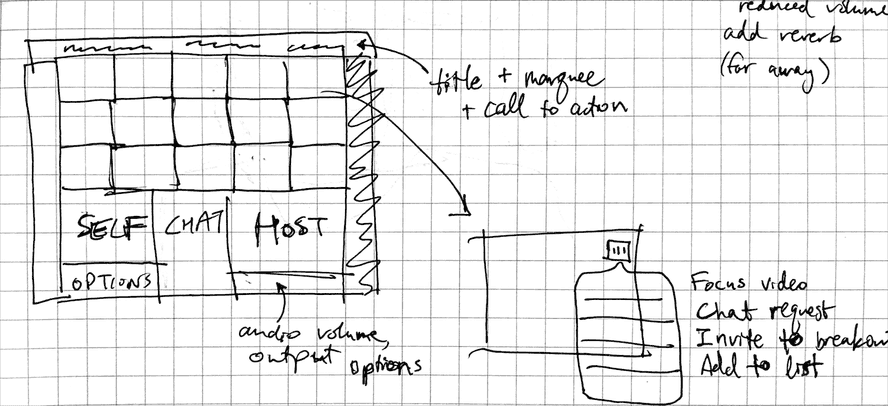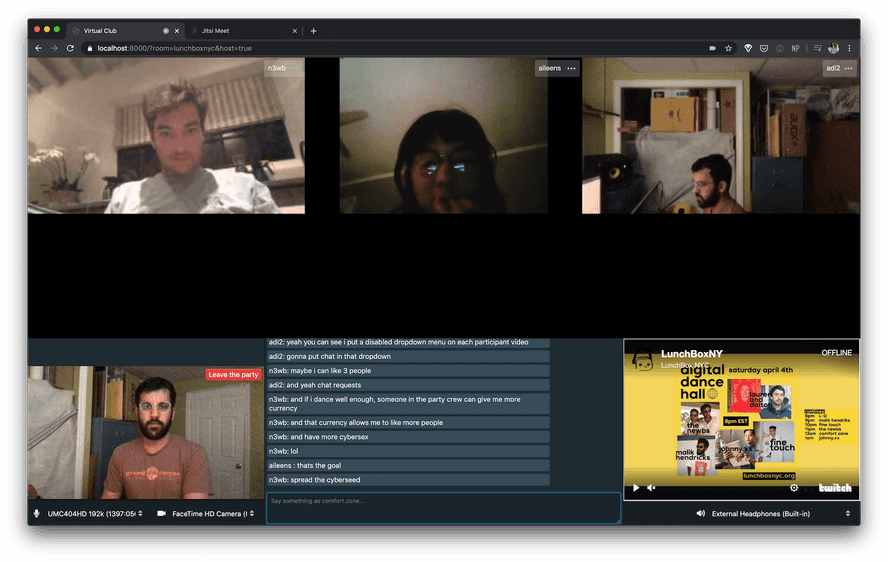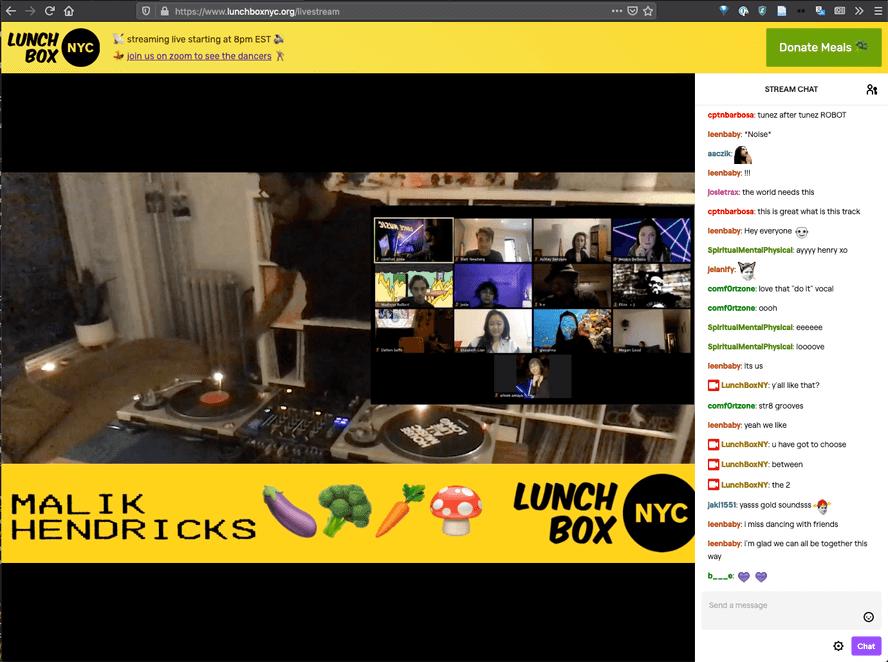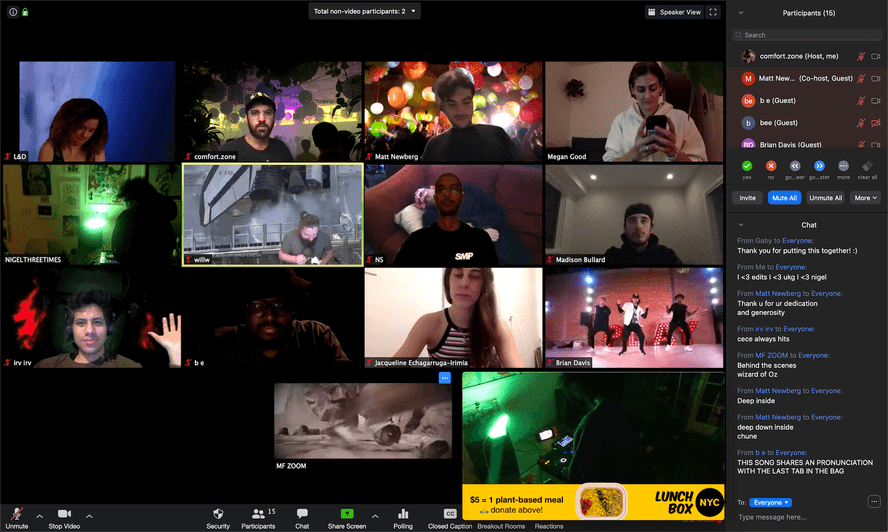ITP blog · thesis-production
Week 12 - Production Update
Thesis is almost over... but this project is just getting started
A lot of development happened since my last substantial blog post. The feedback and interest I've gotten in the project has been encouraging, and I generally feel motivated to create something people could really enjoy using during this period of isolation. I also feel like I'm in a competition to be the first to market in solving this product need... judging by the rumblings I see on tech blogs about the deficiencies of existing tools/platforms. Time to get to work.
Listening vs. Dancing
I've been updating my are.na channel with references and news about the latest in internet party culture. One distinction I want to make up front is a delineation between listening parties and dance parties.
Listening parties have been around for a while on the internet, before the pandemic. Listening parties:
- have a low barrier to entry. you can tune in and leave it on in the background while you do something else at your computer.
- don't encourage much physical movement, especially if you focus on the chat room. sending messages requires your arms to be static at the keyboard.
- have either live music (e.g. Twitch streams) or prerecorded music (like Virtually Nowadays, at the time of this writing).
- sometimes have a visual accompaniment created by a video artist.
The most common form of this in my immediate music community occurs on The Lot Radio website, which features a DJ livestream (usually in The Lot's physical studio) and an accessible chat room:
Since the closure of their physical venue, Nowadays has been using the same setup for their online programmming. Boiler Room is another popular example of this category of event. Any time a group of people chooses to tune into the same internet radio station and has some shared channel of communication during the event, this can be considered a listening party.
Dance parties on the internet are a newer phenomenon, driven entirely by the global practice of social distancing due to COVID-19. They are a subset of listening parties. Internet dance parties:
- provide visibility of other participants through video conferencing. this encourages more immersive socializing and many of the behaviors you would find in a physical dance party, such as:
- dancing
- outfits / costumes
- feature "live" music (performed either by a DJ or a musician).
The most popular platform for this style of event has been Zoom Meetings, the most notable example of which is Club Quarantine:
Design Goals
My thesis project focuses on dance parties, not listening parties. It draws inspiration from a specific kind of club culture (one where the focus is on music; dancing drives the space, rather than sex) and attempts to transmit festive energies through telecommunications mediums.
I wrote out an initial list of must-have features for an internet dance party platform as follows:
- high quality audio stream. the music must not skip or have distortions. this is important for dancers to get in a groove and move their bodies.
- visibility of other dancers through webcam video streams. this doesn't scale up easily for lots of people (20+), so you need a way to break the party into smaller groups and focus on your friends.
- visual stimulation, signifying that you are at a party somehow.
- public text chat room
"Nice to have" features:
- private text chat rooms
- highlight specific video streams for everyone, like go-go dancers, or just someone who looks cool. similar to Zoom's "spotlight video" feature
- livestream VJ
- multiple party "rooms"
- dance floor has only DJ audio stream
- other rooms allow participants to voice chat each other
- discovery of different parties through some kind of indexing/aggregation feature
First prototype
UI mockup
I sketched out a quick UI mockup featuring 4 main features:
- video conference streams
- self video view
- public chat room
- host video view
I figured the "host" video view could be used to show the performer(s) and spotlight dancers. In the first iteration, though, I just plugged a livestream embed in there as a cheap way to get high quality audio and ease the transition for users coming from existing platforms like Twitch and YouTube.
Technical considerations
Out of the available open source options for video conferencing, I found Jitsi Meet to be the most attractive. It basically worked out of the box; after a couple days of hacking with lib-jitsi-meet, I had the basics of a custom video conferencing UI.
More on tech details in another blog post...
From the above mockup and use of the free meet.jit.si service as a conferencing back end, I built like this first prototype:
At this point I had convinced myself that this project is technically feasible. The next goal was to make the web application stable enough for use in a real party environment.
Hosting parties
Since the beginning of April, I had been helping run a virtual party and fundraiser called Lunchbox NYC with my friend Matt. We were curating DJs and hosting streaming parties every Saturday night. This gave me a place to observe what it's like to host a party with some existing platforms like Zoom.
We used Lightstream to mix together DJ audio and broadcast to Twitch. I built a web page to embed the Twitch stream on lunchboxnyc.org so I could have some control over the UX and promote the fundraiser. Some of the key takeaways from the hosting experience on April 11 were:
- virtual backgrounds are important. people like to be able to get creative with them and display some personality. they also encourage more people to turn on their video in a conference, when they don't have to worry about the backdrop of their room
- spotlighting participants' videos is fun and engaging. we used it in two ways: (1) to prompt (sometimes unaware) people to bust a move and (2) to highlight a noteworthy moment or visual going on in one of the video streams
Second prototype
With some additional virtual party hosting experience under my belt, I got back to building. I got the basics of a "virtual background" feature working by masking a user's body with bodypix:
Then I added a flexible, responsive grid layout system for video streams:
Also a "portrait" orientation for videos (zoomed in and cropped to the center of the frame) and a feature to select virtual backgrounds:
Lastly, I added private chat rooms with a request / block system. With all these features I was ready to do a proper user test during the April 18 LunchboxNYC stream...
